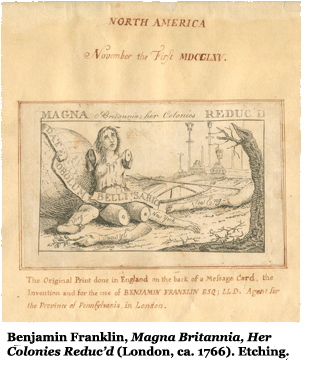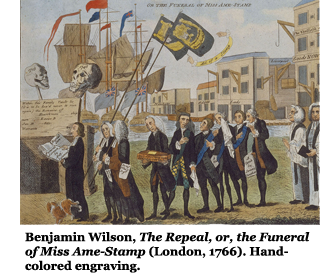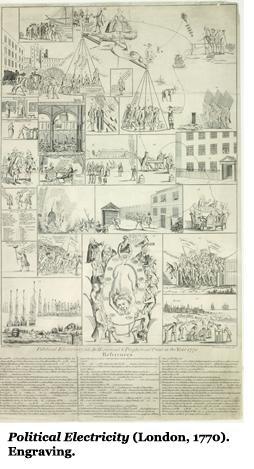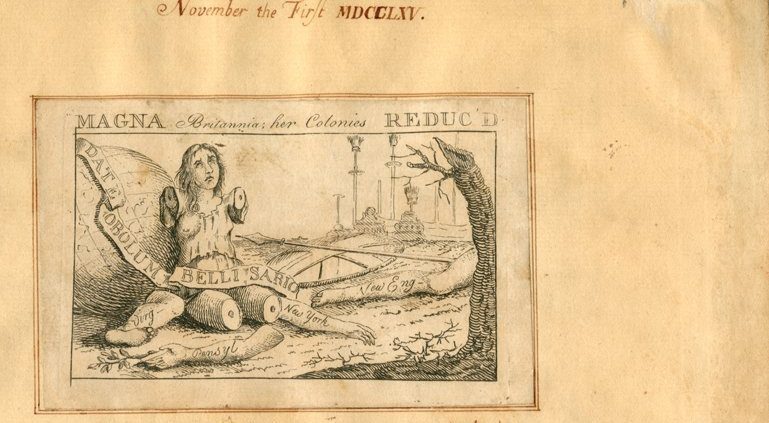Treasures at the Library Company of Philadelphia
 As we enter the final two months of the seemingly endless presidential election season, politics is on nearly everyone’s mind. Political visuals, whether appearing as newspaper cartoons, television commercials, or part of our social media, play a role in shaping the national dialogue about issues facing the electorate. Our 18th-century forbears also recognized the power of visuals in swaying opinion. Commenting in the spring of 1766 on Benjamin Franklin’s cartoon Magna Britannia: Her Colonies Reduc’d illustrated here, Joseph Galloway wrote to Franklin’s son William: “I suspect that the print enclosed by Dr. Franklin to me and several others, is his own. It is certainly a good one, and explains the subject deeply. The lance from the thigh of New England, pointed at the breast of Britannica, is striking, as is indeed every other emblem.”
As we enter the final two months of the seemingly endless presidential election season, politics is on nearly everyone’s mind. Political visuals, whether appearing as newspaper cartoons, television commercials, or part of our social media, play a role in shaping the national dialogue about issues facing the electorate. Our 18th-century forbears also recognized the power of visuals in swaying opinion. Commenting in the spring of 1766 on Benjamin Franklin’s cartoon Magna Britannia: Her Colonies Reduc’d illustrated here, Joseph Galloway wrote to Franklin’s son William: “I suspect that the print enclosed by Dr. Franklin to me and several others, is his own. It is certainly a good one, and explains the subject deeply. The lance from the thigh of New England, pointed at the breast of Britannica, is striking, as is indeed every other emblem.”
Magna Britannia addressed the intensity of debate surrounding the Stamp Act imposed by Great Britain on America. A dismembered, impotent Britannia has slid off the globe and sits surrounded by her scattered limbs identified as different American colonies. The proud English oak has withered and died while in the background of the cartoon British ships sit idle. A rejected olive branch lies abandoned near Britannia’s torso. The banner unfurled across Britannia’s body reading “Date Obolum Bellisario” reminded viewers of the fate of the Roman military hero who was reduced to beggary when accused of treason.
 The Library Company owns the only surviving copy of this cartoon created by Franklin in late 1765 or early 1766. Pierre Eugėne Du Simitiėre (1737-1784), an artist, compulsive collector, and museum proprietor, mounted a copy of the cartoon into a scrapbook that the Library Company acquired from Du Simitiėre’s 1785 estate sale. He recorded on the scrapbook page: The Original Print done in England on the back of a Message Card, the Invention and for the Use of BENJAMIN FRANKLIN ESQ: L.L.D. Agent for the Province of Pennsylvania, in London.” The image was later re-engraved in Philadelphia in a larger format and included a long explanation of the scene, a copy of this print is also in the Library Company’s holdings. Another copy of the cartoon in the collection of the American Philosophical Society includes a manuscript note explaining that Franklin’s cartoon cards were handed out to members of Parliament as they entered the chamber to discuss the repeal of the Stamp Act. The moral, as explained by Franklin, that “the Colonies may be ruined, but that Britain would thereby be maimed” apparently proved effective in persuading Parliament to repeal the Stamp Act. The Stamp Act generated other political cartoons including The Repeal, or, the Funeral of Miss Ame-Stamp (1766) and John Singleton Copley’s The Deplorable State of America (1765).
The Library Company owns the only surviving copy of this cartoon created by Franklin in late 1765 or early 1766. Pierre Eugėne Du Simitiėre (1737-1784), an artist, compulsive collector, and museum proprietor, mounted a copy of the cartoon into a scrapbook that the Library Company acquired from Du Simitiėre’s 1785 estate sale. He recorded on the scrapbook page: The Original Print done in England on the back of a Message Card, the Invention and for the Use of BENJAMIN FRANKLIN ESQ: L.L.D. Agent for the Province of Pennsylvania, in London.” The image was later re-engraved in Philadelphia in a larger format and included a long explanation of the scene, a copy of this print is also in the Library Company’s holdings. Another copy of the cartoon in the collection of the American Philosophical Society includes a manuscript note explaining that Franklin’s cartoon cards were handed out to members of Parliament as they entered the chamber to discuss the repeal of the Stamp Act. The moral, as explained by Franklin, that “the Colonies may be ruined, but that Britain would thereby be maimed” apparently proved effective in persuading Parliament to repeal the Stamp Act. The Stamp Act generated other political cartoons including The Repeal, or, the Funeral of Miss Ame-Stamp (1766) and John Singleton Copley’s The Deplorable State of America (1765).
 As might be expected, events leading up to the American Revolution and the war itself unleashed a flurry of cartoons from both sides of the Atlantic and these visuals are well represented in the Library’s collections. The broadside entitled Political Electricity contains 31 vignettes Illustrating how corrupt British policy could lead to an economic crisis both home and abroad. Politics and electricity are intertwined throughout as can be seen in the inclusion of Franklin, representing the union of experimental science with liberal politics, flying a kite or the depiction of Lord Bute’s head as the glass cylinder portion of an electrostatic generator being cranked by the French.
As might be expected, events leading up to the American Revolution and the war itself unleashed a flurry of cartoons from both sides of the Atlantic and these visuals are well represented in the Library’s collections. The broadside entitled Political Electricity contains 31 vignettes Illustrating how corrupt British policy could lead to an economic crisis both home and abroad. Politics and electricity are intertwined throughout as can be seen in the inclusion of Franklin, representing the union of experimental science with liberal politics, flying a kite or the depiction of Lord Bute’s head as the glass cylinder portion of an electrostatic generator being cranked by the French.
During the 19th century, the intensity of feeling surrounding financial crises, abolitionism, and the outbreak of the Civil War also generated partisan images on all sides of the issues. Mocking pretensions, personalities, and assumptions, political cartoons then, as now, hoped to persuade viewers of the rightness of their opinions or at least bring the issues to the forefront for discussion.




Leave a Reply
Want to join the discussion?Feel free to contribute!